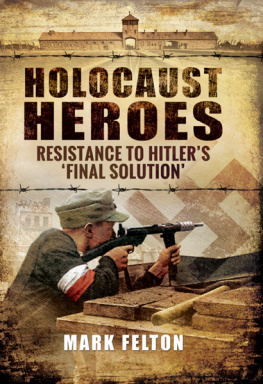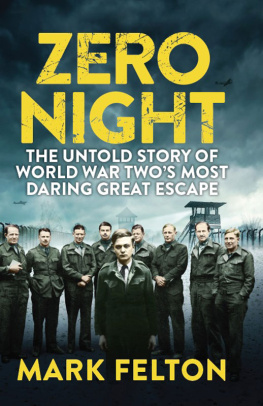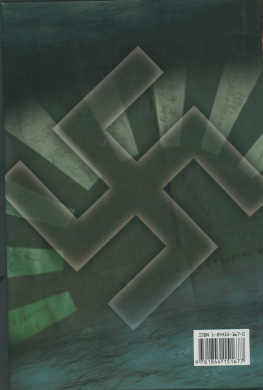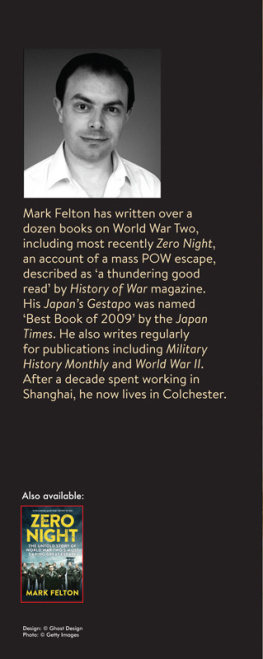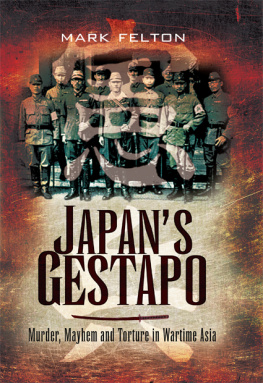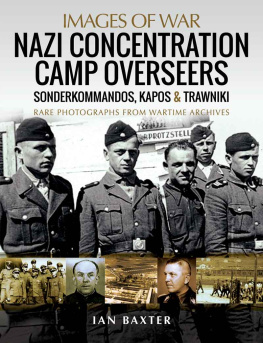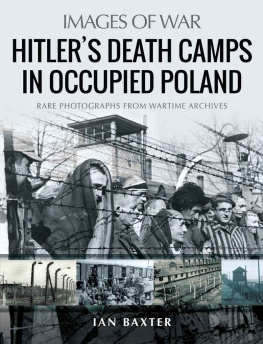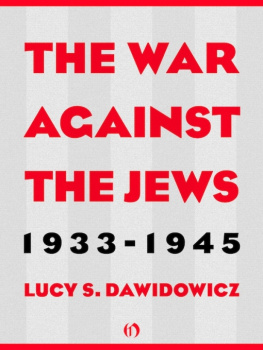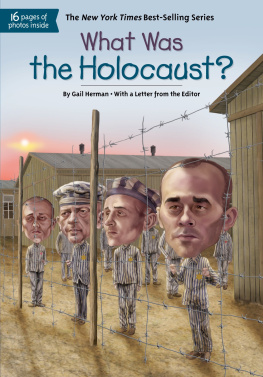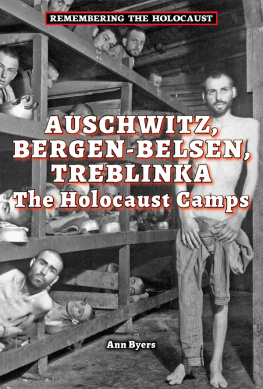
First published in Great Britain in 2016 by
PEN & SWORD MILITARY
an imprint of
Pen & Sword Books Ltd
47 Church Street
Barnsley
South Yorkshire
S70 2AS
Copyright Mark Felton, 2016
ISBN: 978-1-78340-057-7
PDF ISBN: 978-1-47388-185-3
EPUB ISBN: 978-1-47388-184-6
PRC ISBN: 978-1-47388-183-9
The right of Mark Felton to be identified as the author of this work has been asserted by him in accordance with the Copyright, Designs and Patents Act 1988.
A CIP catalogue record for this book is available from the British Library.
All rights reserved. No part of this book may be reproduced or transmitted in any form or by any means, electronic or mechanical including photocopying, recording or by any information storage and retrieval system, without permission from the Publisher in writing.
Typeset by Concept, Huddersfield HD4 5JL.
Printed and bound in England by CPI Group (UK) Ltd, Croydon CR0 4YY.
Pen & Sword Books Ltd incorporates the imprints of Pen & Sword Archaeology, Atlas, Aviation, Battleground, Discovery, Family History, History, Maritime, Military, Naval, Politics, Railways, Select, Social History, Transport, True Crime, and Claymore Press, Frontline Books, Leo Cooper, Praetorian Press, Remember When, Seaforth Publishing and Wharncliffe.
For a complete list of Pen & Sword titles please contact
PEN & SWORD BOOKS LIMITED
47 Church Street, Barnsley, South Yorkshire, S70 2AS, England
E-mail:
Website: www.pen-and-sword.co.uk
To Fang Fang,
with love as always
Contents
List of Plates
Acknowledgements
The author would like to acknowledge the very kind assistance of staff at the following institutions: The National Archives (Public Record Office), Kew; Yad Vashem Archives, Jerusalem; New Jersey Jewish News; Imperial War Museum, London; The Times of Israel; Jewish Virtual Library; The United States Holocaust Memorial Museum, Washington DC; The British Library, London; Cambridge University Library; and The University of Essex Library. Many thanks as always to my wonderfully talented wife Fang Fang for her advice and practical assistance during the research and writing of this book.
Prologue
The force that has overcome Europe and destroyed entire states within days could cope with us, a handful of youngsters. It was an act of desperation We aspired to only one thing: to sell our lives for the highest possible price.
Mordechai Tenenbaum
Ghetto Resistance Fighter
Hnde hoch! yelled angry-looking SS troopers at the bedraggled Jewish fighters who slowly and awkwardly emerged from a hole beneath the shattered remains of a tall apartment block in Warsaw. Schnell! screamed the Germans, as MP40 machine pistols and Mauser rifles were levelled menacingly at the men and women who stumbled into the dirty, smoke-obscured sunlight on the shattered street. The Jews lean faces were blackened from the smoky fires that ravaged the streets, their clothes torn and dishevelled. Many threw down their pitifully small number of weapons at the feet of the SS; a few old pistols, the occasional bolt-action rifle, as well as knives and other home-made devices. The SS corralled the Jews against the wall of the apartment block. All around could be heard the rough clunk of pistol or rifle shots as resistance continued elsewhere in the ghetto, and often the reply of German automatic weapons. Fires burned everywhere, columns of black smoke rising high into the sky. The SS troopers were almost as dirty as the Jews they hunted, their haggard expressions and sweat-stained uniforms evidence of the terrific level of resistance that they had unexpectedly encountered. They were also in no mood to take prisoners, particularly sub-human Jews.
Line up! demanded an SS sergeant, MP40 machine pistol in his hands. The Jews were pushed roughly back against the wall. Their eyes betrayed no emotion, except perhaps a grim recognition of what was to follow. They had never been under any illusions it had always been a fight to the death. Either resist the planned deportations to the terrible camps that everyone in the Ghetto had heard about, or fight back and take a few of the Nazi bastards with them. Exhausted, malnourished, half-deaf from constant combat and with many among them wounded, the Jewish ghetto fighters showed no fear. The SS sergeant took a few paces back from the line of Jews and turned to his squad. He said nothing, just nodded curtly. The German weapons barked out, the Jews falling back against the wall under a hail of bullets. Then the sergeant went among them, checking for anyone still alive. Spotting movement, he quickly drew his Luger pistol and fired a single shot into the mans head. Right, move out, the sergeant said to his men, wearily. Another Jewish position had been eliminated. But to many in the SS, it seemed as though the job of rooting out the Jewish terrorists would last forever. Didnt these people realize that they were already dead?
Jewish resistance to the Nazis Final Solution occurred throughout Europe many times and it was to take many different forms. As the Jews were progressively relieved of their human rights and property, and herded into walled sections of cities, resistance organizations began to be created from among the imprisoned ghetto populations. Mostly young idealists, they were in the main not trained soldiers but ordinary citizens who were outraged by what was being done to their communities by the German invaders, and who felt that they had to prepare to defend themselves and their loved ones from an increasingly homicidal Nazi racial policy. Some managed to leave the towns and cities and take to the forests to form Jewish partisan groups, striking at the Germans whenever they could and trying to save as many of their own people from destruction as possible. The Germans encountered the most well-organised and ferocious resistance when they began to liquidate the many ghettos that they had created to house the Jews. Most famous is the Warsaw Uprising in 1943, but what occurred in the Polish capital was repeated on a smaller, but no less vicious and lethal scale in ghettos throughout Poland and the occupied Soviet Union, as Jews, weakened by hunger, disease and privation, decided to fight rather than submit themselves to transportation to the death camps. It was not a decision that was entered into lightly. Resistance was almost guaranteed to earn a death sentence from the Germans, but what were the alternatives?
It is now clear that many thousands of primarily young Jews, both men and women, decided that the only course of action was to stand up to the Nazis. In doing so, the resisters faced almost insuperable obstacles. They lacked proper weapons, and were forced to engage in combat with extremely well-armed German units. The Jews were armed only with a few pistols and rifles, home-made Molotov cocktails and whatever weapons they could take from German dead. The Nazis also had tanks, artillery and aircraft, and had no hesitation in deploying these weapons against civilians. Tens of thousands perished as the Nazis ruthlessly crushed Jewish rebellions with the utmost ferocity and violence, but the desperate ghetto fighters also killed many Germans.
Judged against what happened to Jewish ghetto populations after they were transported to the camps, it is clear that though this resistance may appear unwise, even foolish, it was not entered into with any hope of victory, rather of showing the Germans that they couldnt kill Jews with impunity.
Later, in the concentration camps, many Jews still refused to submit to the Nazis, and in several famous incidents they rose up and attempted to escape in large numbers or to destroy the apparatus that was responsible for eliminating them as a people. The German response was predictably barbaric and coldly ruthless.
Next page
